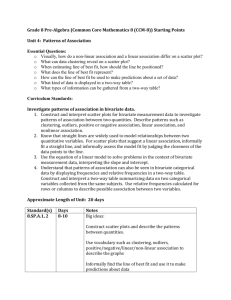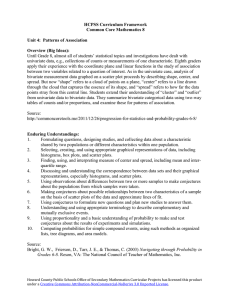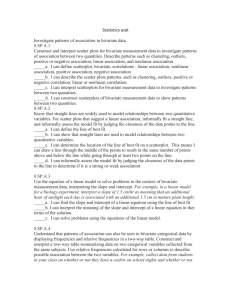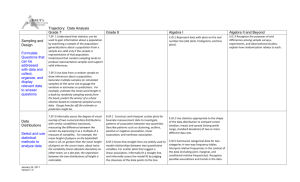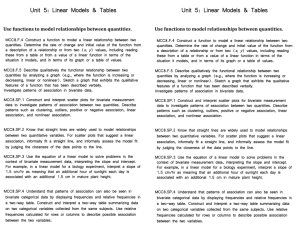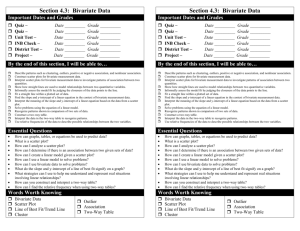NJDOE MODEL CURRICULUM PROJECT CONTENT AREA
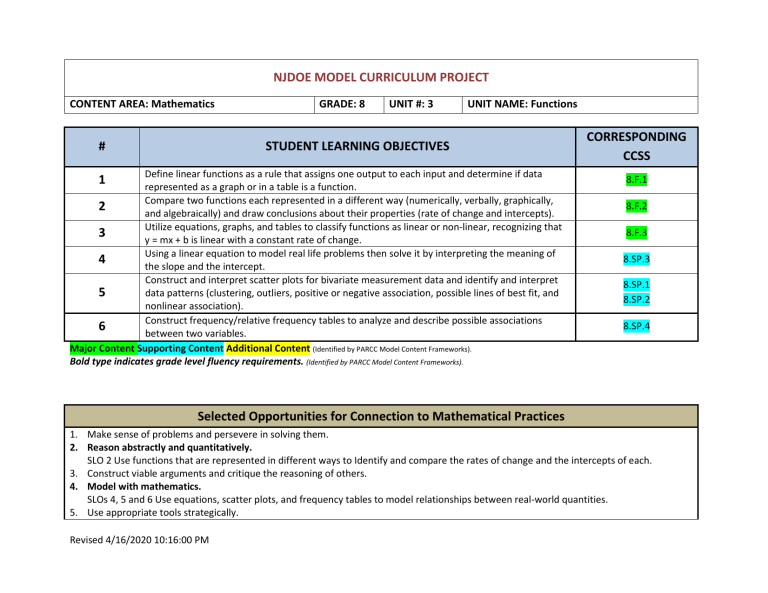
NJDOE MODEL CURRICULUM PROJECT
GRADE: 8 UNIT #: 3 UNIT NAME: Functions CONTENT AREA: Mathematics
# STUDENT LEARNING OBJECTIVES
1
2
3
4
5
Define linear functions as a rule that assigns one output to each input and determine if data represented as a graph or in a table is a function.
Compare two functions each represented in a different way (numerically, verbally, graphically, and algebraically) and draw conclusions about their properties (rate of change and intercepts).
Utilize equations, graphs, and tables to classify functions as linear or non-linear, recognizing that y = mx + b is linear with a constant rate of change.
Using a linear equation to model real life problems then solve it by interpreting the meaning of the slope and the intercept.
Construct and interpret scatter plots for bivariate measurement data and identify and interpret data patterns (clustering, outliers, positive or negative association, possible lines of best fit, and nonlinear association).
6
Construct frequency/relative frequency tables to analyze and describe possible associations between two variables.
Major Content Supporting Content Additional Content
(Identified by PARCC Model Content Frameworks).
Bold type indicates grade level fluency requirements.
(Identified by PARCC Model Content Frameworks).
CORRESPONDING
CCSS
8.F.1
8.F.2
8.F.3
8.SP.3
8.SP.1
8.SP.2
8.SP.4
Selected Opportunities for Connection to Mathematical Practices
1.
Make sense of problems and persevere in solving them.
2.
Reason abstractly and quantitatively.
SLO 2 Use functions that are represented in different ways to Identify and compare the rates of change and the intercepts of each.
3.
Construct viable arguments and critique the reasoning of others.
4.
Model with mathematics.
SLOs 4, 5 and 6 Use equations, scatter plots, and frequency tables to model relationships between real-world quantities.
5.
Use appropriate tools strategically.
Revised 4/16/2020 10:16:00 PM
NJDOE MODEL CURRICULUM PROJECT
CONTENT AREA: Mathematics GRADE: 8 UNIT #: 3 UNIT NAME: Functions
6.
Attend to precision.
7.
Look for and make use of structure.
SLO 2 Identify the rate of change and the intercepts of functions represented in different ways.
8.
Look for and express regularity in repeated reasoning.
All of the content presented at this grade level has connections to the standards for mathematical practices.
Bold type identifies possible starting points for connections to the SLOs in this unit.
Code #
8.F.1
8.F.2
8.F.3
8.SP.1
8.SP.2
8.SP.3
8.SP.4
Common Core State Standards
Understand that a function is a rule that assigns to each input exactly one output. The graph of a function is the set of ordered pairs consisting of an input and the corresponding output.
Compare properties of two functions each represented in a different way (algebraically, graphically, numerically in tables, or by verbal descriptions). For example, given a linear function represented by a table of values and a linear function represented by an algebraic expression, determine which function has the greater rate of change.
Interpret the equation y=mx +b as defining a linear function, whose graph is a straight line; give examples of functions that are not linear. For example, the function A = s 2 giving the area of a square as a function of its side lengths is not linear because its graph contains the points (1, 1), (2, 4), and (3, 9) which are not on a straight line.
Construct and interpret scatter plot for bivariate measurement data to investigate patterns of association between two quantities. Describe patterns such as clustering, outliers, positive or negative association, linear association, and nonlinear association.
Know that straight lines are widely used to model relationships between two quantitative variables. For scatter plots that suggest a linear association, informally fit a straight line, and informally assess the model fit by judging the closeness of the data points to the line.
Use the equation of a linear model to solve problems in the context of bivariate data interpreting the slope and intercept.
For example, in a linear model for a biology experiment, interpret a slope of 1.5 cm/hr as meaning that an additional hour of sunlight each day is associated with an additional 1.5 cm in mature plant height.
Understand the patterns of association can also be seen in bivariate categorical data by displaying the frequencies and relative frequencies in a two-way table. Construct and interpret a two-way table summarizing data on two categorical
Revised 4/16/2020 10:16:00 PM
NJDOE MODEL CURRICULUM PROJECT
CONTENT AREA: Mathematics GRADE: 8 UNIT #: 3 UNIT NAME: Functions variables collected from the same subjects. Use relative frequencies calculated for rows or columns to describe possible association between the two variables. For example, collect data from students in your class on whether or not they have a curfew on school nights and whether or not they have assigned chores at home. Is there evidence that those who have a curfew also tend to have chores?
Major Content Supporting Content Additional Content
(Identified by PARCC Model Content Frameworks).
Bold type indicates grade level fluency requirements.
(Identified by PARCC Model Content Frameworks).
Revised 4/16/2020 10:16:00 PM
